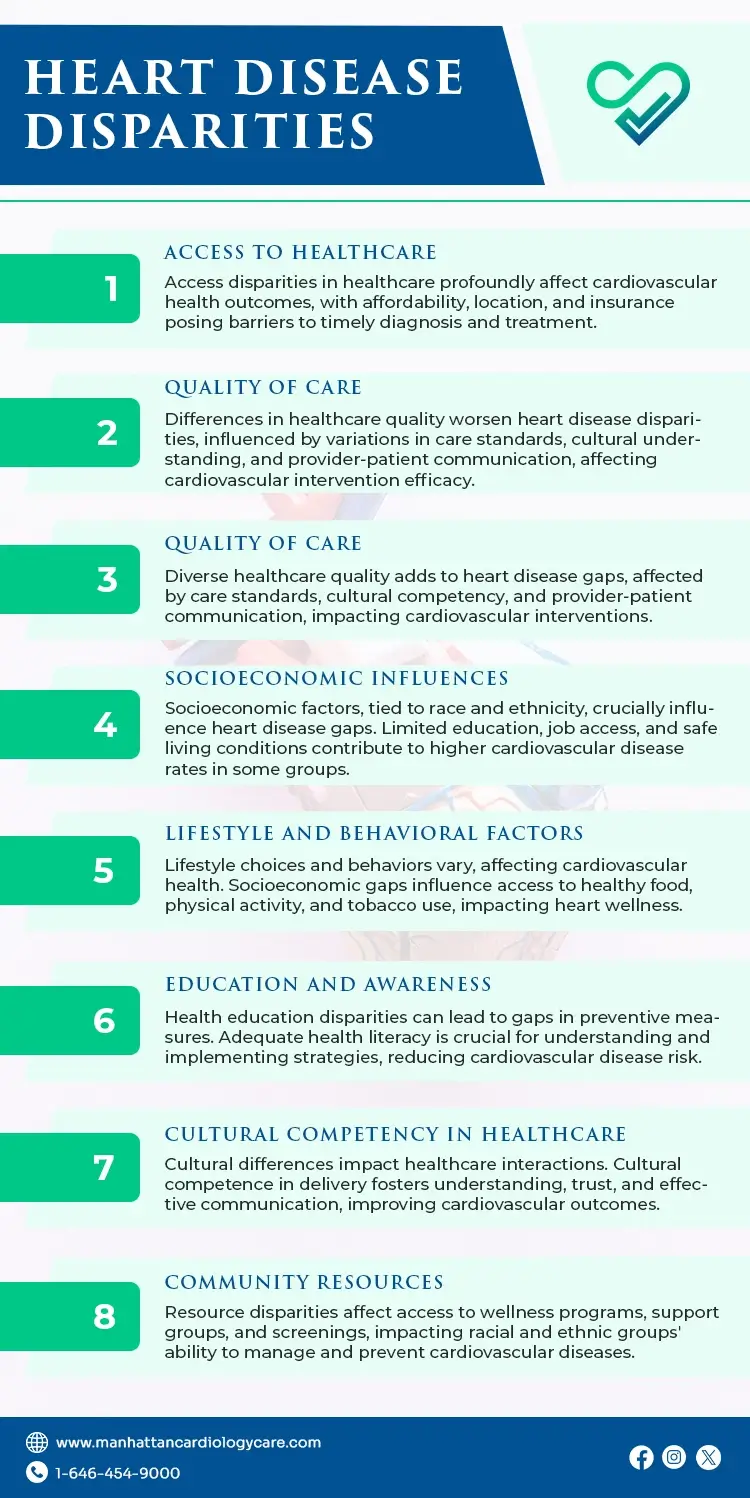Ever thought if your background, the color of your skin, or your family’s ethnicity that you carry, could actually influence your heart health?
It’s a question many of us have thought about at some point, and today we’re about to answer this question for you.
In today’s blog, we’re going to talk about heart disease by race, discovering the racial disparities in cardiovascular disease by explaining the relationship between race, ethnicity, and cardiovascular health.
Join us on this journey as we answers how diverse backgrounds can shape our heart’s well-being.
Table of contents
How Do Race & Ethnicity Play a Role in Cardiovascular Disease?
Race and ethnicity influence cardiovascular health through a combination of genetic, socioeconomic, lifestyle, and healthcare factors.
Genetic variations, socioeconomic disparities, cultural practices, and environmental conditions contribute to variations in the prevalence, risk factors, and outcomes of cardiovascular diseases across different racial and ethnic groups.
Recognizing and addressing these factors is quite important for developing targeted interventions and promoting equitable heart health for all.
Heart Disease Disparities
In the world of cardiovascular health, the term “heart disease disparities” reflect the imbalances in heart health outcomes experienced by different racial and ethnic groups.
Here are the factors contributing to heart disease disparities:
-
Access to Healthcare:
Disparities in access to healthcare services significantly impact cardiovascular health outcomes. Factors such as affordability, geographical location, and insurance coverage can create barriers to timely diagnosis, treatment, and preventive care.
-
Quality of Care:
Varying quality of healthcare services further contributes to heart disease disparities. Variations in the standard of care, cultural competency, and communication between healthcare providers and patients can impact the effectiveness of cardiovascular interventions.
-
Socioeconomic Influences:
Socioeconomic factors, closely linked to race and ethnicity, play a vital role in heart disease disparities. Limited access to education, employment opportunities, and safe living conditions can contribute to higher rates of cardiovascular diseases in certain populations.
-
Lifestyle and Behavioral Factors:
Differences in lifestyle choices and behavioral factors contribute to variations in cardiovascular health. Socioeconomic disparities often influence access to healthy food, opportunities for physical activity, and the prevalence of tobacco use, impacting overall heart wellness.
-
Education and Awareness:
Disparities in health education and awareness initiatives can contribute to gaps in preventive measures. Adequate health literacy is crucial for understanding and implementing preventive strategies, reducing the risk of cardiovascular diseases.
-
Cultural Competency in Healthcare:
Cultural differences can affect the effectiveness of healthcare interactions. Ensuring cultural competence in healthcare delivery promotes understanding, trust, and effective communication between healthcare providers and patients, contributing to better cardiovascular outcomes.
-
Community Resources:
Disparities in the availability of community resources, such as wellness programs, support groups, and preventive screenings, can impact the ability of individuals from different racial and ethnic backgrounds to manage and prevent cardiovascular diseases.
How Do Cardiovascular Disease Risks Vary by Race & Ethnicity?
Exploring the landscape of cardiovascular health reveals distinct patterns in the prevalence and risks associated with heart-related conditions across different racial and ethnic groups.
-
High Blood Pressure (Hypertension):
African Americans:
- Prevalence: African Americans tend to develop hypertension earlier in life compared to other racial groups.
- Severity: Hypertension in African Americans often presents with higher average blood pressure readings and is associated with more severe consequences.
Hispanics:
- Prevalence: Hispanics, particularly those of Mexican descent, face a higher risk of developing hypertension.
- Awareness and Control: Hypertension awareness and control may be lower among Hispanics, emphasizing the need for targeted education and interventions.
Asian Americans:
- Prevalence: Hypertension rates vary among different Asian subgroups, with higher prevalence in certain populations.
- Underdiagnosis: Asian Americans may experience challenges in hypertension diagnosis due to variations in blood pressure norms.
- Type 2 Diabetes:
Hispanics:
- Prevalence: Hispanics, especially those with roots in Mexico, have a higher prevalence of type 2 diabetes.
- Risk Factors: Factors such as genetic predisposition, dietary habits, and sedentary lifestyles contribute to elevated diabetes risk.
African Americans:
- Prevalence: African Americans face a higher risk of type 2 diabetes, often linked to genetic factors and disparities in healthcare access.
- Complications: Diabetes complications, including cardiovascular issues, are more common in this population.
Native Americans:
- Prevalence: Native Americans, particularly Pima Indians, exhibit one of the highest rates of type 2 diabetes globally.
- Lifestyle Factors: A combination of genetic susceptibility and lifestyle factors contributes to this heightened risk.
Which Ethnic Group Has The Highest Rate of Heart Disease?
-
Heart Failure:
African Americans:
- Prevalence: African Americans experience a higher rate of heart failure compared to other racial groups.
- Contributing Factors: Factors such as hypertension, diabetes, and genetic predisposition contribute to the increased susceptibility to heart failure in this population.
Hispanics:
- Risk Factors: Hispanics, particularly those with roots in the Caribbean, face elevated risk factors for heart failure, including diabetes and obesity.
- Cultural Considerations: Cultural factors may influence dietary habits and lifestyle choices, impacting heart health.
-
Coronary Artery Disease and Heart Attack:
South Asians:
- Prevalence: South Asians, including those from India, Pakistan, Bangladesh, and Sri Lanka, exhibit a higher predisposition to coronary artery disease.
- Risk Profile: Elevated rates of diabetes, hypertension, and abnormal cholesterol levels contribute to the increased risk of heart attacks in this ethnic group.
African Americans:
- Early Onset: African Americans often experience coronary artery disease and heart attacks at an earlier age.
- Higher Severity: The severity and complications associated with heart attacks can be more pronounced in this population.
-
Stroke:
American Indians and Alaska Natives:
- Prevalence: This ethnic group faces a higher rate of strokes compared to other populations.
- Contributing Factors: Genetic predisposition, higher rates of diabetes, and limited access to healthcare contribute to the increased stroke risk.
African Americans:
- Higher Incidence: African Americans have a higher incidence of strokes, with factors like hypertension and diabetes playing significant roles.
- Younger Age Group: Strokes in African Americans often occur at a younger age, emphasizing the need for early prevention and intervention.
Conclusion
It’s evident that understanding cardiovascular health across different racial and ethnic groups is crucial. At Manhattan Cardiology Care, we are committed to providing inclusive, personalized care that addresses the unique needs of our diverse community.
Your heart health matters, regardless of your background, and our team is here to guide you on the path to a healthier, heart-strong future.
– Disclaimer –
This blog is for informational & educational purposes only, and does not intend to substitute any professional medical advice or consultation. For any health related concerns, please consult with your physician, or call 911.


